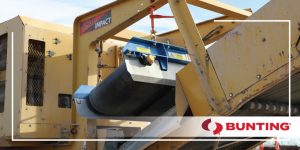Do You Need a Ferrite or Rare Earth Crossbelt Magnet?
Do You Need a Ferrite or Rare Earth Crossbelt Magnet?

Bunting’s permanent crossbelt magnets are among our most widely used magnetic separators. These devices consist of a permanent magnet block placed between two pulleys, around which a self-cleaning belt rotates. Installation is straightforward—simply position the crossbelt magnet above a conveyor transporting material. When ferrous metal enters the magnetic field generated by the crossbelt magnet, it gets lifted and separated from the rest of the material flow. Applications for crossbelt magnets span industries like mining, quarrying, recycling centers, and food processing facilities.
Traditionally, these magnets have been made using ferrite materials, which are known for their durability and cost-effectiveness. The ferrite blocks are assembled into a stainless-steel casing and magnetized afterward to create the magnetic field. More recently, however, rare earth crossbelt magnets have become available as an alternative to the standard ferrite models.
What Is a Rare Earth Crossbelt Magnet?
Rare earth crossbelt magnets utilize high-strength neodymium iron boron magnet blocks instead of the lower-powered ferrite magnets. Unlike ferrite magnets, which are magnetized after assembly, rare earth magnets are assembled while already charged and magnetic.
Rare earth crossbelt magnets were developed to meet the growing demand for magnets that are both lighter and stronger than conventional ferrite options. Stronger, lighter magnets were especially desirable for mobile operations like crushers and screening equipment. At first glance, it might seem like rare earth magnets are always superior due to their increased strength and reduced weight. However, there are certain limitations to consider when comparing rare earth crossbelt magnets to their traditional ferrite counterparts.
Potential Issues with Rare Earth Crossbelt Magnets
The saying "stronger isn't always better" certainly applies here. While operating, rare earth crossbelt magnets can present several challenges compared to ferrite magnets, including:
A limited magnetic field:
Some rare earth crossbelt magnets have a relatively shallow magnetic field. This means that the magnetic pull extends only a short distance below the magnet's surface and into the conveyed material. Even though the field may be stronger, its reach is shorter. Consequently, rare earth crossbelt magnets need to be positioned closer to the material being transported. In some cases, this isn’t feasible, especially when dealing with large material surges.
Excessive surface magnetic force:
Rare earth crossbelt magnets exert a powerful magnetic attraction on the surface of the magnet block. However, this can pose problems when separating larger pieces of tramp metal. In certain situations, the magnetic force can be so strong that the captured metal cannot be automatically removed by the self-cleaning belt. This could lead to damage to the belt, bearings, and motors. Manual removal of large metal pieces is also risky and potentially hazardous.
Which Crossbelt Magnet Should You Choose?
This article is not meant to discredit rare earth crossbelt magnets. They are an excellent choice for many applications. For instance, if the depth of the conveyed material is consistent and relatively thin, rare earth crossbelt magnets can be positioned closer to the material, allowing for effective separation of smaller tramp metal.
Similarly, if the metal contaminants in the material are smaller in size, rare earth crossbelt magnets often provide better separation. It’s important to note that other types of magnetic separators, such as pulley magnets or drum magnets, may be more appropriate depending on the specific requirements of your operation.
In general, if the tramp metal being handled is larger in size, a traditional ferrite crossbelt magnet is typically the better option.
If you’re unsure which crossbelt magnet is best suited for your particular needs, don’t hesitate to reach out to us. Our team of experts would be happy to assist you in finding the perfect crossbelt magnet tailored to your requirements.
For additional information, feel free to get in touch with Bunting today.
With the excellent abrasion resistance and strength, HP Chute Liners are widely being applied as good wear solution.
We can design and build chutes for any application. We specialize in the construction of our own HP chromium carbide plate. However, we can also make chutes from hardened steel such as mild steel, stainless steel and AR steel.
Feature
1. Good surface finish
2. Accurate size on fabrication parts
3. Quenching and tempering to obtain better wear resistance.
4. High wear & impact resistance, high weldability and easy installation.
Our service
1. Produce qualified wear resistant parts
2. Design and installation of boltless mill liners
3. Under certain working conditions, the mill liner material selection consulting service will be realized for a longer time service life
4. Grinding machine production and fineness improvement consulting services.
5. We can provide OEM / ODM to our customers.
Typical applications of HP Chute Liners
· Ore Terminal: bulk materials handling, stacker reclaimers, bunkers, hoppers, chutes, transfer cars, vibro-feeders.
· Sintering plant – Intensive mixers, drum mixers, hoppers, cyclones, sinter discharge tables / crash decks, sinter crusher spikes and grizzly bars, wind boxes, downcomers, dedusting and waste gas fan rotors and casings, hot and cold vibratory screens etc.
· Coking plant – chutes, hoppers, coke distribution cones, coke pushers, coke crushers, coke cutter, coal pulverizer liners, coke screening etc.
· Blast furnace – hoppers, distribution chutes, skip cars, bell and hopper assembly, throat amour plates, vibro-feeders, gas scrubbing, screening decks etc.


Discharge Funnel Parts,Hardfacing Chute Liners,Chutes Hopper Liners,Mill Abrasion Linings
HuiFeng Wear Resistant Group , https://www.hpwearsolution.com